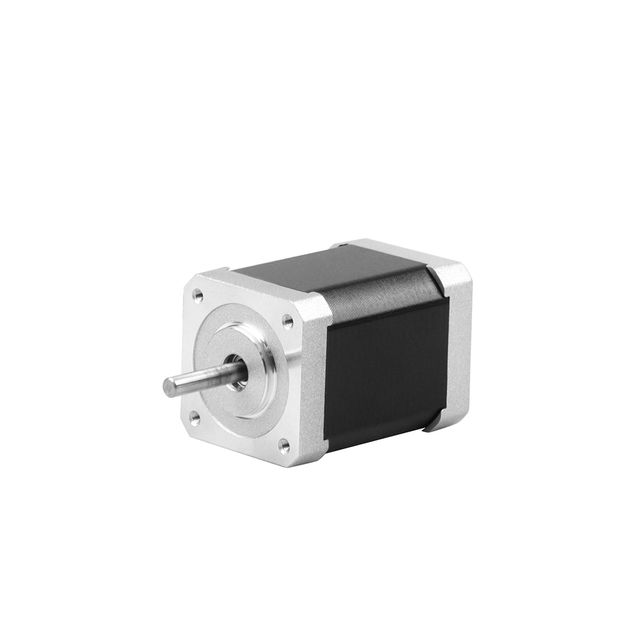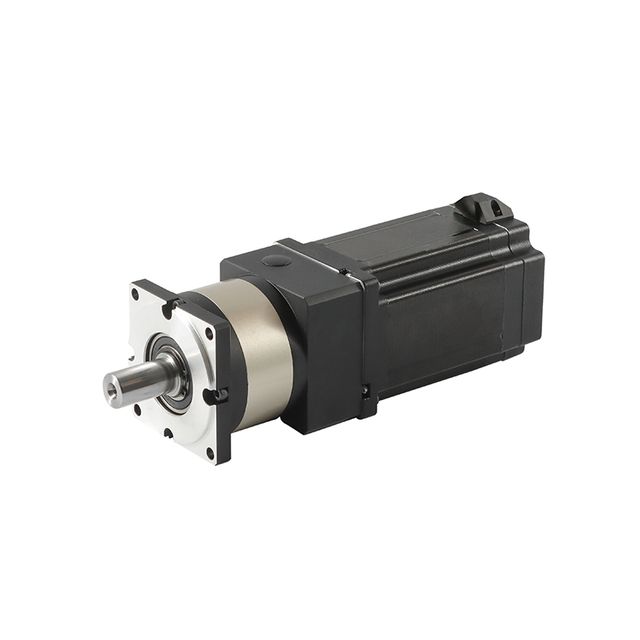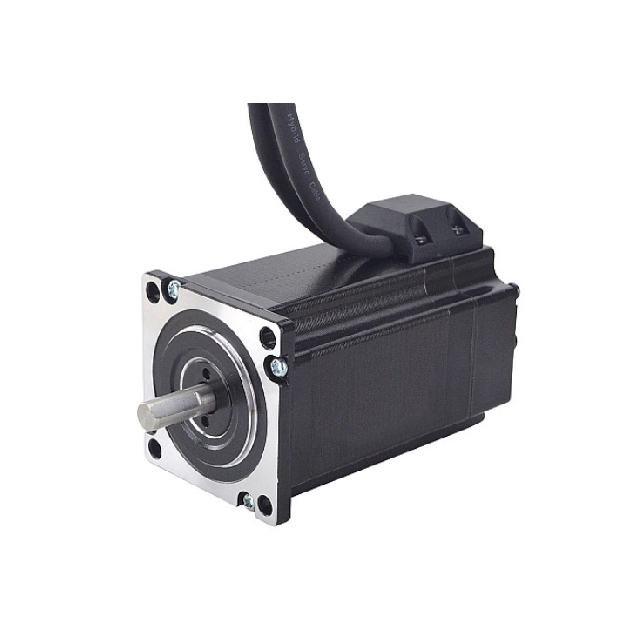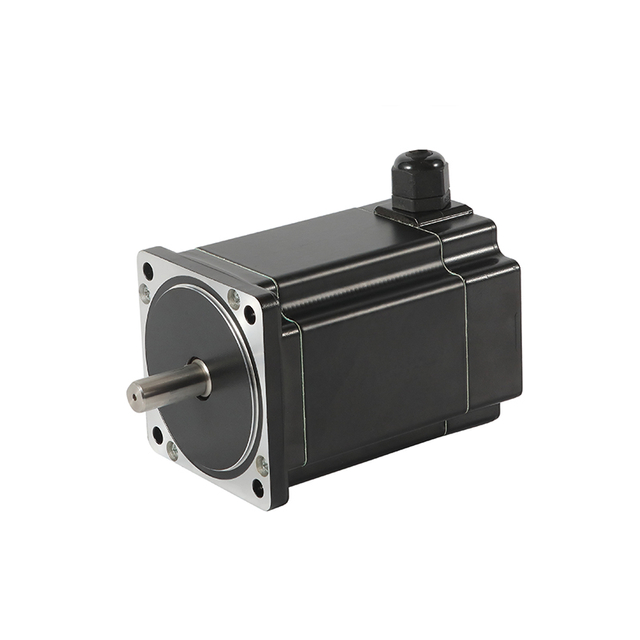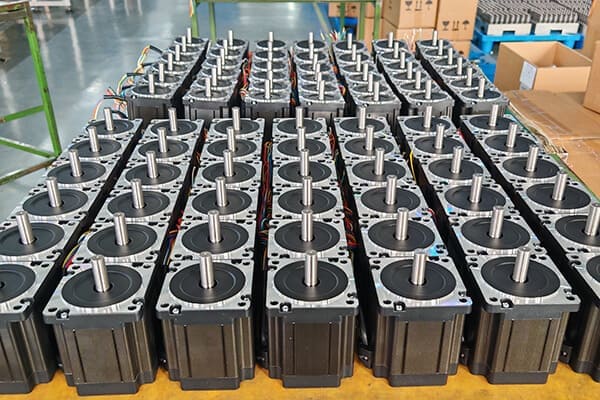
In the world of motion control systems, understanding the difference between Stepper Motors and servo motors is crucial for selecting the right drive mechanism for precision applications. Both motor types serve the purpose of converting electrical energy into mechanical motion, yet they do so through distinct principles and performance characteristics. In this comprehensive guide, we will break down the key differences between stepper and servo motors, explore their advantages, disadvantages, applications, and help you make an informed choice for your automation, robotics, or industrial projects.
Understanding the Basics of Stepper Motors
A stepper motor is a type of electromechanical device that converts electrical pulses into precise mechanical movements. Unlike conventional motors that spin continuously when power is applied, stepper motors rotate in discrete steps. Each pulse sent to the motor represents one movement increment — hence the name “stepper.” This unique capability makes them exceptionally useful in applications requiring accurate position control, such as CNC machines, 3D printers, and robotics.
How Stepper Motors Work
The operation of a stepper motor is based on the principle of electromagnetic induction. Inside the motor, there are two main components: the stator (stationary part) and the rotor (rotating part). The stator contains multiple coils arranged in groups called phases. When electrical current flows through these coils in a specific sequence, it generates a rotating magnetic field.
The rotor, which can be a permanent magnet or a soft iron core, aligns itself with the magnetic field. Each time the control circuit energizes a new coil phase, the rotor moves a fixed angular distance — known as the step angle. This process repeats rapidly, producing controlled rotational motion.
For example, a typical stepper motor might have 200 steps per revolution, meaning each step moves the shaft 1.8 degrees. By controlling the number of pulses, you can precisely determine how far the motor shaft rotates.
Types of Stepper Motors
There are several types of stepper motors, each designed for specific performance requirements:
1. Permanent Magnet (PM) Stepper Motor
This type uses a permanent magnet rotor and operates with relatively low step angles. PM stepper motors are cost-effective and provide good torque at low speeds, making them ideal for simple automation tasks.
2. Variable Reluctance (VR) Stepper Motor
The VR motor features a soft iron rotor without permanent magnets. Its movement depends on the alignment between the rotor teeth and the stator's magnetic field. It provides high step resolution and smooth operation but generally offers lower torque compared to PM designs.
3. Hybrid Stepper Motor
A hybrid stepper motor combines the best features of both PM and VR types. It includes a toothed permanent magnet rotor for higher torque, finer step angles (as low as 0.9° per step), and superior performance. These are the most commonly used stepper motors in precision control applications.
Open-Loop Control System
One of the defining characteristics of stepper motors is their ability to function in an open-loop control system. In this setup, the controller sends command pulses to the motor driver, which translates them into corresponding electrical signals for the coils. The motor moves one step for each pulse received — without requiring any position feedback.
This makes stepper systems simple, cost-effective, and reliable. However, if the motor is overloaded or the pulses are too rapid, the motor may skip steps, leading to positional errors. In such cases, closed-loop stepper systems (using encoders) can be employed for feedback control.
Step Angle and Resolution
The step angle determines how precisely a stepper motor can position its shaft. It's calculated by the formula:
Step Angle = 360° / (Number of Steps per Revolution)
For example, a 200-step motor has a step angle of 1.8°. The smaller the step angle, the higher the positioning resolution.
Advanced control techniques such as microstepping can further improve resolution by dividing each step into smaller increments. This allows for smoother motion, reduced vibration, and greater accuracy.
Torque Characteristics of Stepper Motors
Stepper motors are renowned for their high torque at low speeds. This feature makes them ideal for applications requiring holding or maintaining a fixed position. When power is applied, the rotor locks into a specific position due to the magnetic field, providing holding torque — even when not moving.
However, torque decreases as speed increases. This is because, at higher speeds, the magnetic fields change too rapidly for the rotor to respond effectively. For this reason, stepper motors are best suited for low- to medium-speed applications where precision is more critical than speed.
Advantages of Stepper Motors
High Precision: Perfect for accurate positioning and repeatable movements.
Simple Control: Operates without the need for encoders or complex feedback systems.
High Reliability: Few moving parts, resulting in long service life and low maintenance.
Excellent Low-Speed Torque: Ideal for applications with static loads or slow movements.
Holding Capability: Maintains position even when stopped, without drift.
Disadvantages of Stepper Motors
Torque Loss at High Speed: Torque decreases significantly with rising speed.
Resonance and Vibration: May experience mechanical resonance at certain frequencies.
Possible Step Loss: Without feedback, missed steps can lead to positioning errors.
Lower Efficiency: Draws constant current, even when stationary.
Despite these limitations, stepper motors remain a popular choice due to their simplicity, reliability, and precision.
Common Applications of Stepper Motors
Stepper motors are used across a wide range of industries due to their versatility and control accuracy. Typical applications include:
3D Printers – for accurate layer positioning
CNC Machines – for tool movement and cutting paths
Textile Machinery – for fabric feed and stitching control
Medical Equipment – in syringe pumps and imaging devices
Security Cameras – for smooth pan and tilt operations
Automated Optical Inspection (AOI) Systems – for fine motion control
Wherever precision and repeatability matter more than high speed, stepper motors are the go-to choice.
In essence, a stepper motor provides a powerful combination of accuracy, reliability, and simplicity. Its discrete step operation allows for precise positioning without the complexity of feedback mechanisms, making it an ideal choice for many automation and control applications. While servo motors may outperform them in dynamic and high-speed environments, stepper motors continue to dominate in fields requiring exact motion control at affordable cost.
Mastering the fundamentals of stepper motors is the first step toward optimizing your motion control system and ensuring consistent, high-precision performance.
Understanding the Basics of Servo Motors
A servo motor is a highly precise and efficient electromechanical device used to control the position, velocity, and acceleration of mechanical components. Unlike traditional motors that operate in open-loop systems, servo motors use closed-loop feedback control, allowing them to maintain accuracy, stability, and responsiveness under varying load conditions.
Servo motors are fundamental in automation, robotics, CNC machinery, and industrial motion control, where precision and performance are critical. Understanding how servo motors work and their essential features will help you select the right motor for your system design.
How Servo Motors Work
The operation of a servo motor is based on the closed-loop feedback principle. In this system, the servo motor continuously receives and compares signals from a controller and a feedback device (such as an encoder or resolver).
When the controller sends a command — for example, to move a shaft to a specific angle — the servo drive delivers electrical current to the motor. As the motor rotates, the encoder measures the actual position and sends feedback to the controller. If there's any difference between the commanded position and the actual position (known as position error), the controller adjusts the input signal to correct it instantly.
This real-time adjustment process enables the servo motor to achieve high positional accuracy, fast response, and smooth motion.
Main Components of a Servo Motor System
A typical servo system consists of three essential parts:
1. Servo Motor
The servo motor itself can be AC or DC, though most modern systems use brushless AC servo motors for greater durability and efficiency. The motor converts electrical energy into precise mechanical motion.
2. Servo Drive (Amplifier)
The servo drive acts as the brain of the system. It receives low-power control signals from the controller and amplifies them into high-power current signals to drive the motor. It also interprets feedback signals and ensures real-time control of torque, speed, and position.
3. Feedback Device
Typically an encoder or resolver, this device provides continuous feedback on the motor's actual position and speed. Feedback is essential for closed-loop correction and ensures that the motor performs as commanded, even under varying load or environmental conditions.
Types of Servo Motors
Servo motors come in several types, each suited for specific performance requirements.
1. AC Servo Motor
The AC servo motor operates on alternating current and is widely used in industrial automation. Brushless AC servo motors are the most popular type due to their high efficiency, low maintenance, and superior torque-speed characteristics.
2. DC Servo Motor
A DC servo motor uses direct current and offers quick response and easy control. However, it typically requires more maintenance because of the brushes and commutator that wear over time.
3. Brushless DC Servo Motor (BLDC)
This type combines the advantages of both AC and DC designs. It eliminates mechanical brushes, resulting in longer lifespan, higher efficiency, and quieter operation. Brushless servo motors are common in robotic joints, aerospace systems, and high-precision automation.
Key Characteristics of Servo Motors
1. Closed-Loop Feedback Control
The primary feature of a servo motor is its closed-loop operation. Continuous feedback ensures that any position or speed error is corrected in real time, maintaining exceptional accuracy and stability.
2. High Torque Across Wide Speed Ranges
Unlike stepper motors that lose torque as speed increases, servo motors maintain consistent torque from low to high speeds. This makes them ideal for dynamic and high-speed applications, such as conveyors, robotics, and CNC machining.
3. Smooth and Precise Motion
With micro-level feedback adjustments, servo motors offer smooth rotation and precise control. This ensures minimal vibration and excellent surface quality in machining or positioning tasks.
4. Rapid Acceleration and Deceleration
Servo systems can accelerate and decelerate quickly due to their high torque-to-inertia ratio. This enables fast and efficient movement in applications that demand quick response times.
5. Energy Efficiency
Because servo motors draw current only when needed, they are more energy-efficient than open-loop systems. This results in lower power consumption, reduced heat generation, and extended operational life.
6. Overload Capability
Servo motors can handle temporary overloads (up to 300% of rated torque) for short durations. This allows them to overcome sudden load changes without stalling or losing accuracy.
Advantages of Servo Motors
Exceptional Precision: Offers sub-degree positioning accuracy.
High Speed and Dynamic Response: Ideal for fast and complex motion profiles.
Torque Consistency: Maintains strong torque over wide speed ranges.
Feedback-Driven Reliability: Automatically corrects errors and maintains performance.
Quiet and Smooth Operation: Minimal noise and vibration compared to stepper motors.
Compact Design: Provides high power density in a small frame size.
Limitations of Servo Motors
Despite their superior performance, servo motors also have certain drawbacks:
Higher Cost: More expensive due to complex electronics and feedback systems.
Requires Tuning: Servo drives must be properly tuned for optimal response.
More Complex Control System: Needs a controller, encoder, and driver integration.
Potential for Oscillation: Poor tuning or feedback errors may cause instability.
Nevertheless, these disadvantages are outweighed by their performance in precision-driven industries.
Typical Applications of Servo Motors
Servo motors are integral to modern automation due to their accuracy, power, and adaptability. Common applications include:
Robotics: For joint control, precise movement, and dynamic manipulation.
CNC Machines: For tool positioning, axis control, and milling precision.
Packaging Machinery: Ensuring synchronized motion for filling, labeling, and cutting.
Conveyor Systems: For regulating speed and movement consistency.
Aerospace and Defense: Used in control surfaces, stabilizers, and navigation systems.
Medical Devices: Powering surgical tools, prosthetics, and imaging systems.
Wherever performance, precision, and reliability matter most, servo motors deliver unmatched results.
Servo Motor vs. Conventional Motors
Servo motors differ from conventional motors in several important ways:
| Parameter | Servo Motor | Conventional Motor |
| Control Type | Closed-loop | Open-loop |
| Accuracy | High (feedback-based) | Low (no feedback) |
| Torque Control | Excellent | Limited |
| Speed Regulation | Precise | Variable |
| Response Time | Fast | Moderate |
| Applications | Robotics, CNC, automation | Fans, pumps, conveyors |
This table highlights why servo systems dominate industries where precision motion control is essential.
In summary, servo motors are the cornerstone of modern motion control technology. Their closed-loop feedback system, high torque, energy efficiency, and exceptional accuracy make them indispensable in industries that rely on speed, precision, and performance.
Whether driving robotic arms, guiding CNC tools, or ensuring exact synchronization in automated systems, servo motors deliver the intelligence and power required for today's most demanding engineering challenges.
Major Differences Between Stepper and Servo Motors
To better understand how these motors differ, let's examine their key parameters side by side.
| Feature | Stepper Motor | Servo Motor |
| Control System | Open-loop | Closed-loop |
| Feedback Device | Not required | Required (encoder/resolver) |
| Position Accuracy | Moderate (0.9°–1.8° step) | High (up to 0.001°) |
| Torque Characteristics | High at low speeds, drops at high speeds | High torque across a wide speed range |
| Speed Range | Limited (below 2000 RPM) | Very wide (up to 5000–6000 RPM) |
| Response Time | Slower | Faster |
| Overload Capacity | Low | High |
| Efficiency | Lower, due to constant current draw | Higher, due to demand-based current control |
| Cost | More affordable | More expensive |
| Typical Applications | 3D printers, CNC routers, medical devices | Robotics, industrial automation, conveyors, servo-driven tools |
Performance Comparison: Stepper vs Servo Motors
When it comes to precision motion control, two motor types dominate the field — stepper motors and servo motors. Both serve the purpose of controlling movement, but they differ greatly in how they operate, perform, and respond to system demands. Understanding the performance differences between stepper and servo motors is crucial for selecting the right motor for your application, whether it's a robotic arm, CNC machine, or industrial automation system.
Below is a detailed comparison of their torque, speed, accuracy, efficiency, and overall performance characteristics.
1. Torque and Speed Performance
Stepper Motors
Stepper motors deliver maximum torque at low speeds, which makes them ideal for applications requiring slow, controlled movement or static holding. Because each step represents a precise increment of motion, stepper motors are excellent for low-speed positioning.
However, as speed increases, torque drops significantly due to the inductive reactance of the coils. At high speeds, they may lose synchronization or stall if the load exceeds their torque capacity. Therefore, steppers are best suited for low to medium-speed applications that prioritize torque over velocity.
Servo Motors
Servo motors maintain high torque across a broad speed range. Their closed-loop feedback system enables them to adjust current dynamically, allowing for consistent torque even at high rotational speeds. This characteristic makes servo motors perfect for high-speed and high-dynamic applications, such as robotics, conveyors, and CNC spindles.
Additionally, servo motors can accelerate and decelerate quickly, delivering smooth transitions during rapid direction changes without losing torque or stability.
✅ Verdict:
Stepper motors excel at low-speed torque, while servo motors outperform in high-speed and high-power applications.
2. Positioning Accuracy and Feedback Control
Stepper Motors
Stepper motors operate in an open-loop control system, meaning they move a fixed amount for each input pulse. Under normal load conditions, this provides reliable positioning without the need for feedback devices.
However, if the load exceeds capacity or if pulses are sent too quickly, the motor may skip steps without detection. This can lead to positioning errors in systems that require high precision or variable load handling.
Servo Motors
Servo motors operate in a closed-loop feedback system, constantly comparing the commanded position with the actual position via encoders or resolvers. Any deviation triggers an automatic correction, ensuring the motor always reaches the exact target point.
This feedback mechanism allows servo systems to achieve sub-degree accuracy, typically within 0.001°, making them ideal for applications where absolute precision is critical.
✅ Verdict:
Stepper motors provide good accuracy for simple tasks, but servo motors deliver superior precision through continuous feedback correction.
3. Efficiency and Energy Consumption
Stepper Motors
A stepper motor continuously draws its rated current, even when it's not moving or under low load. This results in constant power consumption and increased heat generation. The inefficiency can lead to thermal issues in compact systems unless properly managed.
Servo Motors
Servo motors, by contrast, are demand-driven. They draw only the necessary current required to maintain or change position. This intelligent energy use makes servo systems significantly more efficient, with less heat output and longer component lifespan.
✅ Verdict:
Servo motors are more energy-efficient and generate less heat compared to stepper motors, especially in variable-load applications.
4. Dynamic Response and Acceleration
Stepper Motors
Due to their discrete step-based operation, stepper motors have limited acceleration and deceleration capabilities. Rapid changes in speed or direction can cause the rotor to lose synchronization, resulting in missed steps or mechanical vibration.
They are therefore more suitable for applications requiring gradual speed profiles rather than frequent or high-speed movement changes.
Servo Motors
Servo motors are designed for high dynamic response. With their low rotor inertia and closed-loop feedback, they can accelerate and decelerate rapidly, adapting instantly to control commands. This makes them ideal for robotic joints, pick-and-place systems, and high-speed assembly lines.
✅ Verdict:
Servo motors deliver far better acceleration, responsiveness, and dynamic performance than stepper motors.
5. Smoothness and Noise Levels
Stepper Motors
Stepper motors move in distinct steps, which can cause vibration and audible noise, especially at low speeds. While microstepping technology helps smooth out movement by dividing steps into smaller increments, slight resonance or mechanical noise can still occur in precision applications.
Servo Motors
Servo motors operate smoothly and quietly, thanks to continuous rotation control and feedback regulation. Their motion is fluid, without noticeable stepping, making them ideal for quiet or vibration-sensitive environments, such as medical devices and optical systems.
✅ Verdict:
Servo motors offer smoother and quieter operation, while stepper motors may exhibit slight vibration at certain speeds.
6. Overload Handling and Stability
Stepper Motors
Stepper motors have limited overload capacity. If the torque demand exceeds their rated output, they will stall immediately and may skip steps. This lack of self-correction can lead to positional drift over time.
They also tend to resonate at specific speeds, which can reduce performance and cause mechanical instability unless dampened or microstepped properly.
Servo Motors
Servo motors feature excellent overload capability, typically up to three times their rated torque for short periods. This allows them to handle sudden load variations smoothly without losing position or control. Their closed-loop feedback also prevents instability by continuously adjusting torque output.
✅ Verdict:
Servo motors outperform steppers in overload handling, stability, and load adaptability.
7. Maintenance and Longevity
Stepper Motors
Stepper motors are robust and simple. They have no brushes or feedback components (in most cases), leading to minimal maintenance and a long operational life. Their mechanical design is straightforward, making them highly reliable in clean and controlled environments.
Servo Motors
Servo systems contain encoders, feedback circuits, and sometimes bearings that require calibration or replacement over time. Although modern brushless servo motors have significantly improved lifespans, their electronics make them slightly more maintenance-intensive than stepper systems.
✅ Verdict:
Stepper motors are simpler and easier to maintain, while servo motors may need periodic tuning or feedback servicing.
8. Cost and System Complexity
Stepper Motors
Stepper motors are generally more affordable and simpler to integrate, as they require only a driver and controller. Their open-loop control eliminates the need for costly encoders or tuning procedures.
Servo Motors
Servo systems are more expensive due to additional components like encoders, drives, and controllers. They also require careful system tuning to optimize response, which adds to initial setup complexity. However, their superior efficiency and performance can offset the higher cost in long-term operation.
✅ Verdict:
Stepper motors win on cost-effectiveness, while servo motors justify their higher price through performance and energy savings.
9. Summary Table: Stepper vs Servo Performance
| Feature | Stepper Motor | Servo Motor |
| Control Type | Open-loop | Closed-loop |
| Torque at Low Speed | High | Moderate |
| Torque at High Speed | Drops significantly | Maintained |
| Position Accuracy | Good | Excellent |
| Feedback Device | Optional | Required |
| Efficiency | Lower | Higher |
| Noise Level | Noticeable | Quiet |
| Overload Capacity | Low | High |
| Maintenance | Minimal | Moderate |
| Cost | Lower | Higher |
| Best for | Low-speed, precise motion | High-speed, dynamic control |
In summary, stepper motors and servo motors each have unique performance characteristics suited to different types of applications.
Choose a stepper motor when you need precise, low-speed control at an affordable cost and system simplicity.
Choose a servo motor for high-speed, high-torque, and dynamic applications requiring feedback precision and superior efficiency.
Ultimately, the best choice depends on your application's performance requirements, budget, and motion control complexity. By understanding these performance distinctions, engineers and designers can achieve the perfect balance between cost, accuracy, and speed in their automation systems.
Applications of Stepper and Servo Motors
Common Stepper Motor Applications
These applications prioritize positioning accuracy over high-speed motion, making steppers a cost-effective choice.
Common Servo Motor Applications
Servo systems are selected for dynamic performance, speed regulation, and precise motion control in high-demand industrial environments.
Choosing Between a Stepper and Servo Motor
Selecting the right motor for your motion control application is one of the most critical decisions in system design. Both stepper motors and servo motors have proven to be reliable, efficient, and powerful solutions, yet each excels in different operational environments. Understanding their strengths, weaknesses, and appropriate use cases will help ensure that your system performs with optimal accuracy, efficiency, and reliability.
In this article, we will explore the key factors to consider when choosing between a stepper and a servo motor, helping you make an informed, performance-driven decision.
1. Understand Your Application Requirements
Before selecting a motor, the first step is to analyze your application's specific needs. Consider the following:
Speed range – Will your system require slow, controlled motion or high-speed operation?
Torque demands – Does your load require consistent torque at all speeds or only at low RPMs?
Precision – How accurate must the positioning be?
Duty cycle – Will the motor operate continuously or intermittently?
Budget constraints – How much are you willing to invest in the motor, driver, and control system?
These factors form the foundation for deciding between a stepper motor and a servo motor.
2. When to Choose a Stepper Motor
Ideal for Simplicity and Cost-Effectiveness
Stepper motors are the best choice when cost control and design simplicity are key priorities. Because they operate on an open-loop control system, they don't require complex feedback devices like encoders or resolvers. This simplicity not only lowers hardware costs but also minimizes programming and setup time.
Perfect for Low-Speed, High-Torque Applications
Stepper motors provide maximum torque at low speeds, which makes them ideal for applications that require precise, static positioning without the need for high-speed motion. Examples include:
3D printers
CNC milling machines
Plotters and engraving systems
Automated valve actuators
Laboratory and test equipment
At low to moderate speeds, a stepper motor can hold its position firmly and repeatably, offering excellent positional stability without the risk of drift.
Low Maintenance and High Reliability·
With no brushes and minimal electronic components, stepper motors are exceptionally durable. They can operate for years in controlled environments with virtually zero maintenance. This reliability makes them a go-to option for compact systems and budget-conscious designs.
However, Be Mindful Of:
Stepper motors can lose steps under heavy load or rapid acceleration.
Torque decreases significantly at high speeds.
They may generate heat and vibration during prolonged operation.
✅ Choose a Stepper Motor If:
You need a low-cost, simple, and reliable solution for applications requiring precise, low-speed positioning.
3. When to Choose a Servo Motor
If your application requires fast acceleration, dynamic load response, and smooth motion, a servo motor is the better choice. Servo motors deliver consistent torque across a wide speed range, enabling precise control even under varying loads.
Common applications include:
Superior Accuracy with Closed-Loop Control
Unlike stepper motors, servo motors operate in a closed-loop system. Feedback from encoders or resolvers allows the controller to continuously monitor position, speed, and torque, correcting any deviation instantly. This ensures high positional accuracy, even in demanding, high-speed operations.
Energy Efficiency and Smooth Operation
Servo motors consume power only when required, unlike steppers that draw constant current. Their feedback-driven current regulation reduces energy waste and prevents overheating. Additionally, servo systems deliver quiet, vibration-free movement, ideal for applications that require smooth and precise motion.
However, Be Aware Of:
Servo motors are more expensive due to added electronics and feedback components.
They require tuning and calibration during setup.
Maintenance of feedback sensors may be necessary over time.
✅ Choose a Servo Motor If:
Your system demands high speed, precision, and dynamic control — and you're willing to invest in a premium, closed-loop performance solution.
4. Key Factors to Compare
To make the best decision, evaluate the following performance aspects side by side:
| Parameter | Stepper Motor | Servo Motor |
| Control Type | Open-loop | Closed-loop |
| Torque at Low Speed | Very high | Moderate |
| Torque at High Speed | Drops quickly | Maintained |
| Position Accuracy | Good | Excellent |
| Speed Range | Low to medium | Low to very high |
| Efficiency | Lower (constant current) | Higher (variable current) |
| Noise/Vibration | Noticeable | Smooth and quiet |
| Overload Capability | Limited | High (up to 3× rated torque) |
| Setup Complexity | Simple | Complex (requires tuning) |
| Cost | Lower | Higher |
| Maintenance | Minimal | Moderate |
| Best Use Case | Low-speed precision | High-speed performance |
5. Environmental and Operational Considerations
When deciding between a stepper and servo motor, it's important to consider environmental factors such as:
Temperature and humidity – Stepper motors may overheat under continuous load, while servo systems manage heat more effectively.
Load variability – Servo systems adapt well to fluctuating loads; stepper motors perform best with steady, predictable loads.
Space limitations – Steppers are compact and easier to integrate into small devices.
For cleanroom or medical applications, the quiet and smooth operation of servo motors makes them preferable. In contrast, for industrial automation where cost and simplicity dominate, stepper motors remain a strong choice.
6. Long-Term Cost and Performance Trade-Off
While stepper motors offer lower upfront costs, servo systems often provide greater long-term value. Their energy efficiency, speed performance, and adaptive feedback can result in reduced downtime and higher throughput over time.
In scenarios where precision failures could cause costly defects — such as in automated manufacturing or robotic assembly — the reliability of servo feedback control justifies the investment.
Conversely, if your operation involves repetitive, predictable movements, a well-sized stepper motor can deliver outstanding performance at a fraction of the cost.
7. Practical Guidelines for Selection
Here's a quick decision checklist:
| Application Scenario | Recommended Motor Type |
| Low-speed precision control | Stepper motor |
| High-speed operation | Servo motor |
| Constant torque requirement | Stepper motor |
| Variable or dynamic load | Servo motor |
| Tight budget | Stepper motor |
| Energy efficiency required | Servo motor |
| Simple integration | Stepper motor |
| High-end industrial automation | Servo motor |
8. Final Thoughts
Both stepper and servo motors are invaluable in modern automation, but their success depends on choosing the right one for your specific operational demands.
Choose a stepper motor for cost-effective, low-speed, high-torque applications where precision and simplicity matter most.
Choose a servo motor when you need high performance, feedback precision, and efficiency at varying speeds and loads.
By aligning your motor selection with your application requirements, performance goals, and budget, you can ensure optimal productivity, reliability, and efficiency in your system design.
Conclusion
Both stepper motors and servo motors play vital roles in modern automation and motion control. The decision between the two ultimately depends on your application's speed, torque, precision, and budget requirements. Stepper motors offer simplicity and affordability, while servo motors provide superior performance, adaptability, and control.
Understanding these distinctions ensures that you can optimize your machinery for efficiency, accuracy, and reliability—the foundations of successful automation systems.
English
العربية
Français
Русский
Español
Português
Deutsch
italiano
日本語
한국어
Nederlands
Tiếng Việt
ไทย
Polski
Türkçe
ພາສາລາວ
ភាសាខ្មែរ
Bahasa Melayu
ဗမာစာ
Filipino
Bahasa Indonesia
magyar
Română
Čeština
Монгол
қазақ
Српски
हिन्दी
فارسی
Slovenčina
Slovenščina
Norsk
Svenska
українська
Ελληνικά
Suomi
Հայերեն
עברית
Latine
Dansk
Shqip
বাংলা
Hrvatski
Afrikaans
Gaeilge
Eesti keel
Oʻzbekcha
latviešu
Azərbaycan dili
Български
Català


